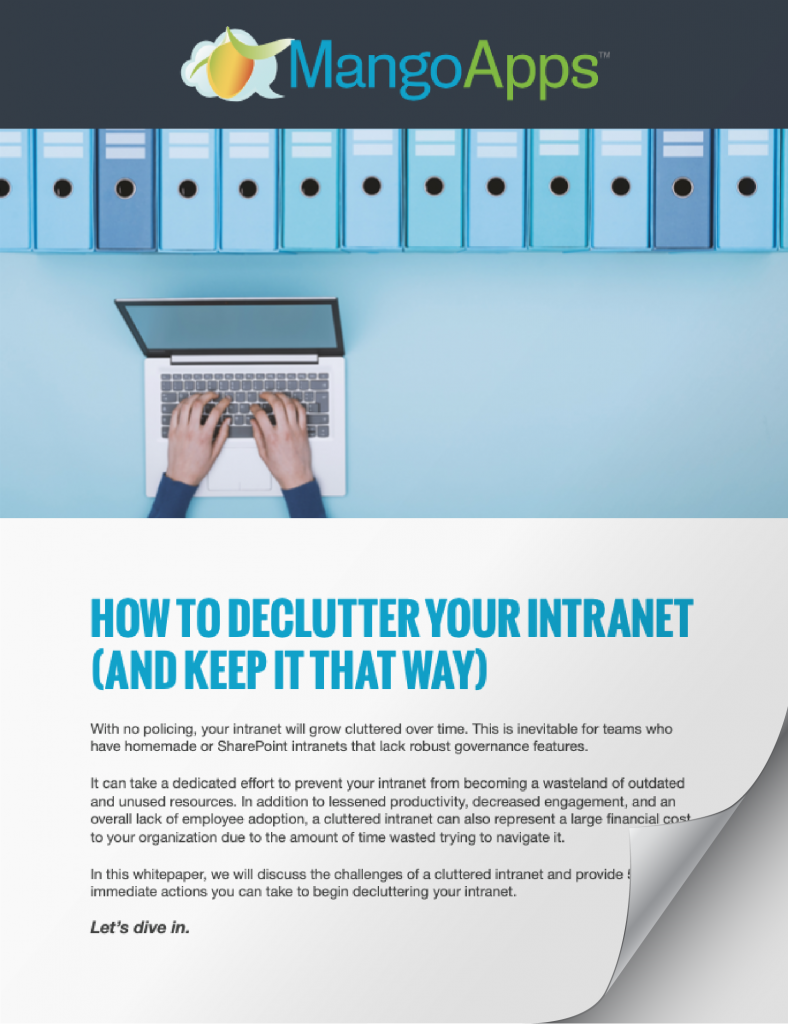Most company intranets are the digital equivalent of a messy teenager’s bedroom, with piles of dirty clothes on every surface. An intranet content audit can help you fix this.
Nested folders with no overriding logic, search that only returns exact matches in the title, inconsistent file names, partially updated versions of the same file in different places—the hallmarks of a useless intranet are familiar to anyone who’s worked on a team with outdated tools.
The larger your company is, the more likely it is that you desperately need to declutter your intranet. At the same time, the larger your team, the less feasible and more challenging it is to change.
So how do you fix it?
Get a modern intranet, obviously. But that takes time and costs money, so here are 5 things you can do right now to make the best of the current situation.
Even if you only have control over part of your intranet, conducting an audit can improve your department’s experience. Potentially, it can also act as a pilot program for the rest of the company.

1. Watch people use it
Ask a couple colleagues to show you how they typically navigate the intranet. Put twenty minutes on their calendar, and ask them to show you how they get to the content they use most frequently. Ask them what they like and don’t like about the way it’s set up.
Find patterns, and then find ways to remove unused items and consolidate common roundabout paths to content.
Another way to get data on this is to run a survey. You’ll get less detail, but it’s easier to spot larger trends. Keep it short, and tie each question to something specific that it is in your power to change.
A mix of surveys and 1:1 discussions will arm you with the best balance of information. Hopefully, it will also give you a to-do list you can refer to as you run your intranet audit.
2. Establish a data policy
You probably have this in a document somewhere buried in your IT team’s portion of the intranet. Ideally, it lists out your policies for how to name files, proper metadata, and some language around how to decide where things are put. Generally speaking, it establishes intranet best practices.
Has anyone read it? No.
Many companies try to address this by sending out memos or scheduling meetings to go over the policy. This is a losing battle.
Instead, pick a few high traffic folders or pages, and fix the content. Remove duplicates, update or remove anything old, give everything consistent names—make it perfect. Lead by example. When someone screws it up, which you can bet will happen soon, politely ask them to fix it. If they ignore you, fix it yourself.
This in combination with step one has the potential to get other people on board for the changes you’re making. This is good. The more intranet audit champions you have, the better.

3. Take an inventory
Make a list of folders, paths, and amount of content in each. Put it in a spreadsheet. If possible, include volume and recency of activity.
You can’t fix a problem until you understand it. Once you have an inventory, start chipping away at it. Take note of bloated folders, outdated pages, and repetitive information. Then, find a way to consolidate and refresh. For inspiration on this refresh, see our intranet design examples.
This can involve a lot of time-consuming manual effort. It is usually helpful to start small; pick the highest-traffic areas, and start there. Prioritize content that is important and keep it organized. Make sure it is findable without having to wade through a bunch of irrelevant, disorganized clutter.
This will naturally deprioritize less important and less frequently needed items and folders, which is good. Decluttering your intranet from top to bottom is likely an impossible task for one person or team.
4. Establish content governance
If your intranet has governance features built into it, it’s unlikely you’ve made it this far. That said, if they’re there, set rules around how long a piece of content stays up before it either gets archived or flagged for a relevancy check. This ensures that old information disappears over time, which builds trust.
See how MangoApps handles auto-governance
If you don’t have this luxury, figure out a way to do it manually, at least with your high-traffic content. One way to do this is to pick the most important items, and create a spreadsheet with links to them. In this spreadsheet, list the last time each folder, wiki, or document was checked for relevancy and updated.
Once a quarter or year, fire up that spreadsheet, do an intranet audit, and make sure everything is up to date and in the right place.

Again, a little goes a long way. Even if you only do this with a small percentage of your content, it will have value. You just have to make sure you’re applying yourself in the high traffic areas your colleagues are actually going.
5. Pay attention to your own patterns
Every time you struggle to find something, take note of where you looked for it first.
Then, go back and put it in that place. Think about how you could organize things to match your own tendencies. This will likely serve others, too.
This may be the smallest scale item on this list, but you can have high confidence in the outcome.
The case for a modern intranet
All of the above is time-consuming. It’s a big, manual effort that is likely to be outgunned by apathetic colleagues. Without a modern intranet platform to automate this work away, you’re fighting a losing battle. Furthermore, you’re doing so in a way that is costing you money every day.
Upgrading to a modern intranet offers not only a better interface and a functional search, but other key intranet features like automated content governance, freshness checks, AI-generated metadata, and the ability for departments to own their own content without IT involvement. All of these things can preclude the need for any future intranet audits.
To learn more about how a modern intranet can affect your business, read our whitepaper on how to declutter your intranet, explore MangoApps’ modern intranet solution, or read our customer stories from TeamHealth, symplr, or Great Harvest Bread.








